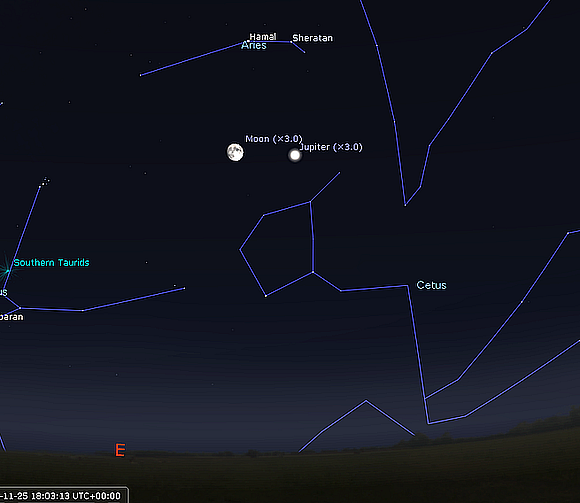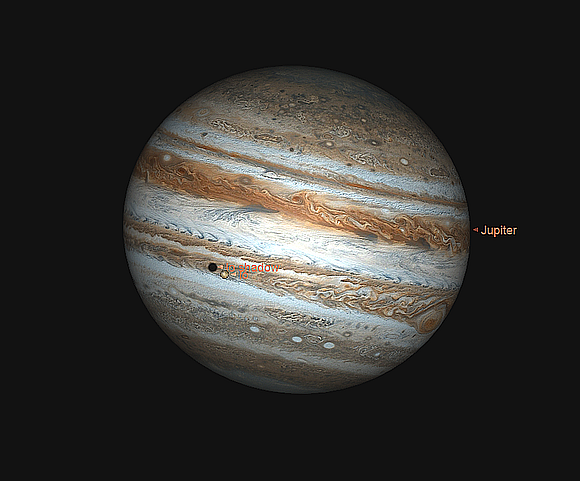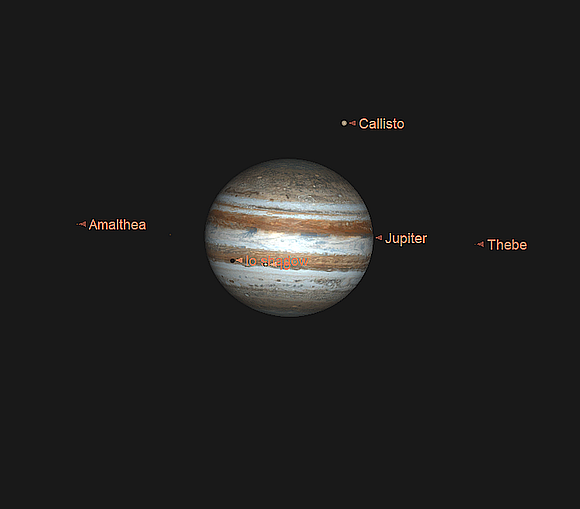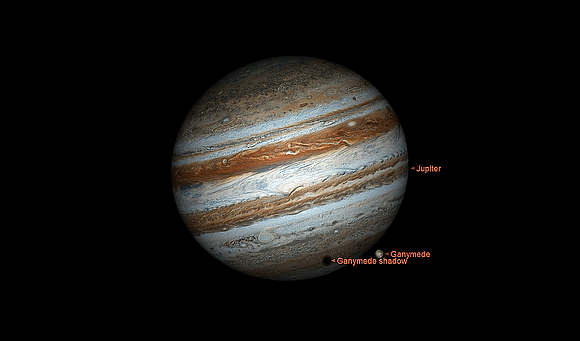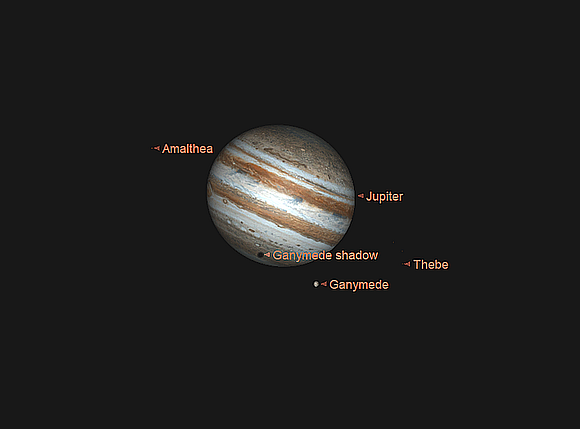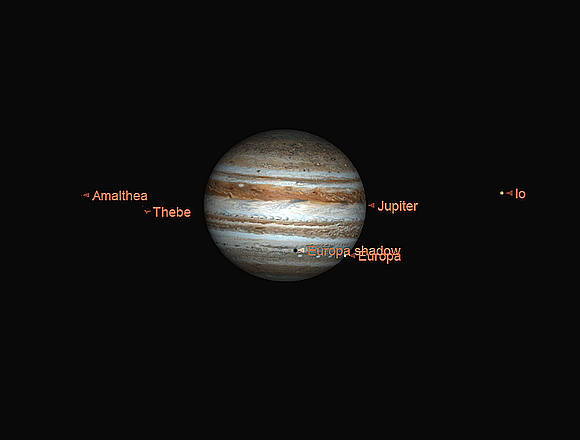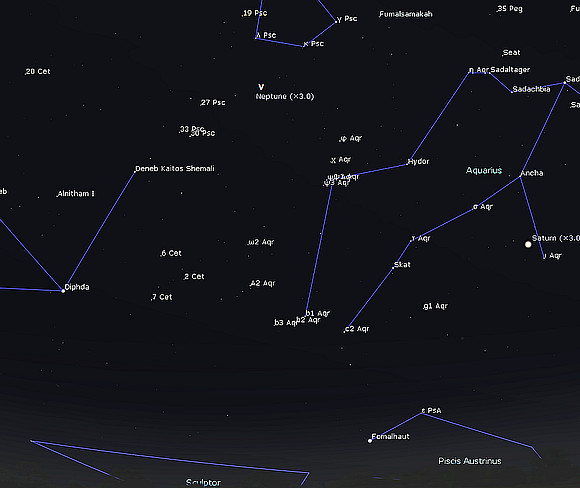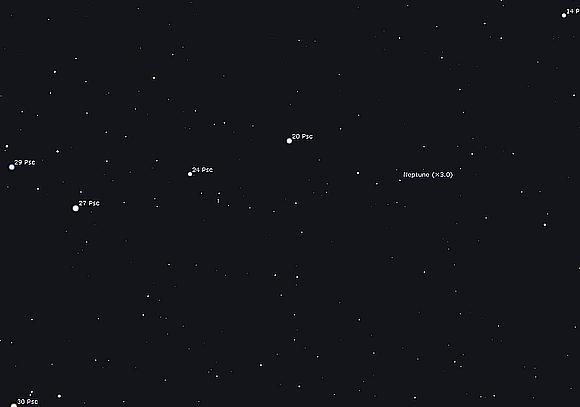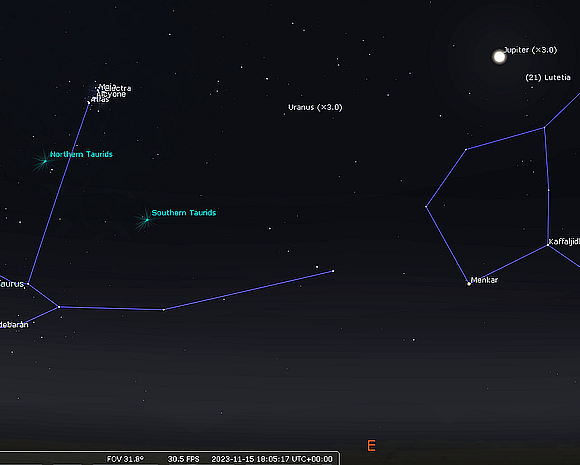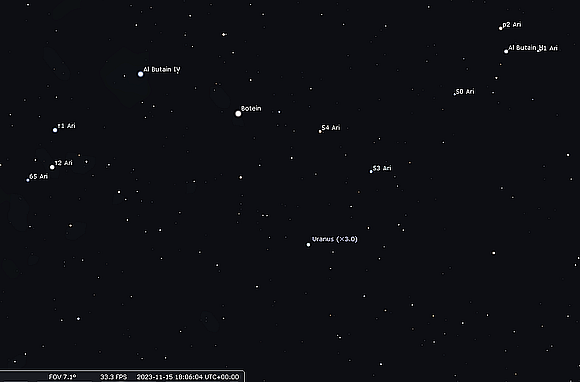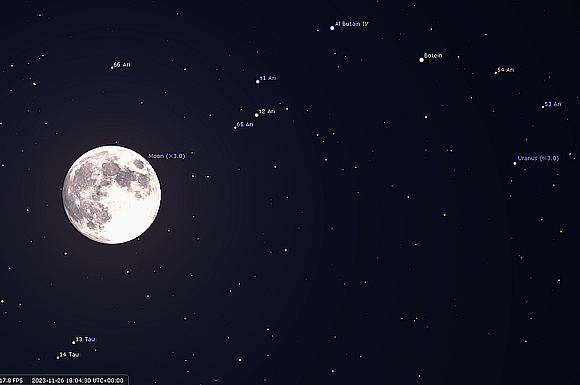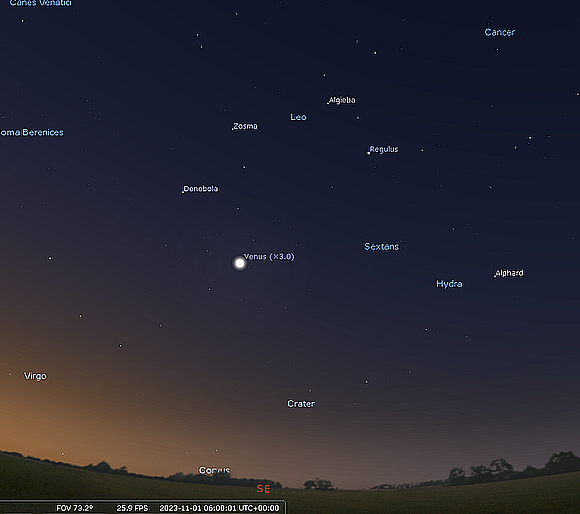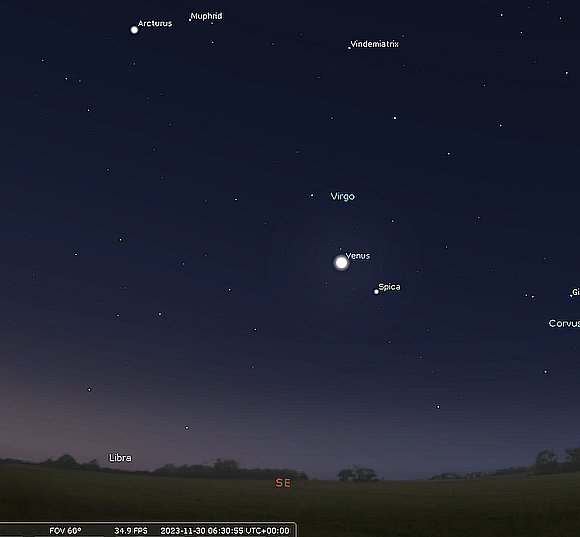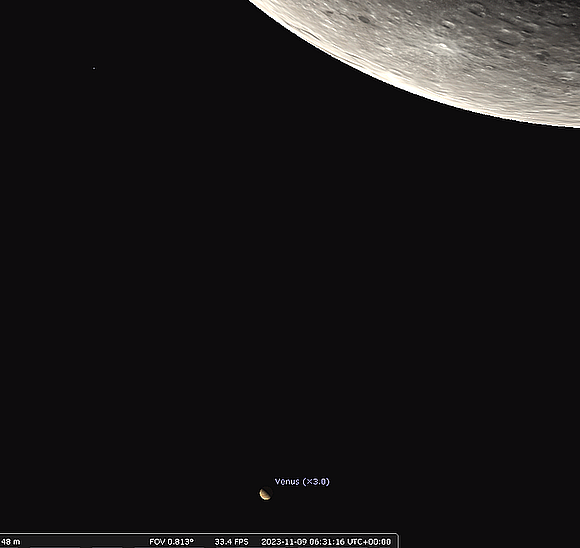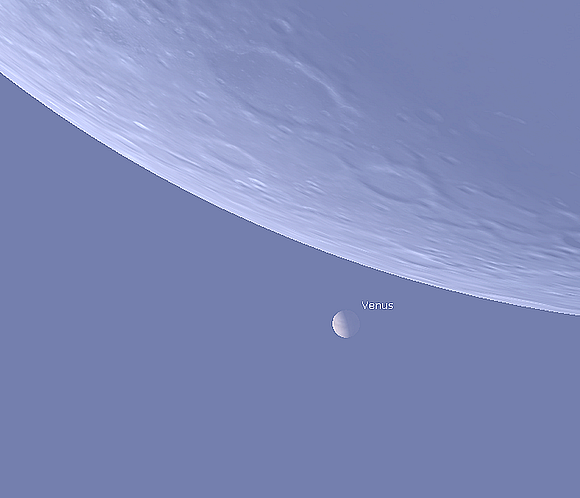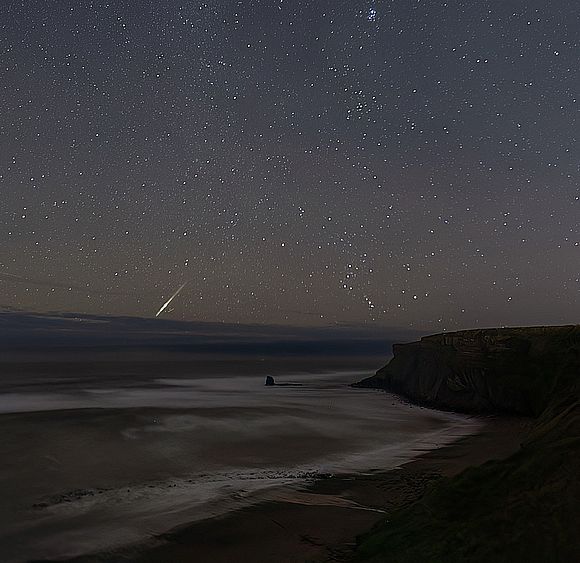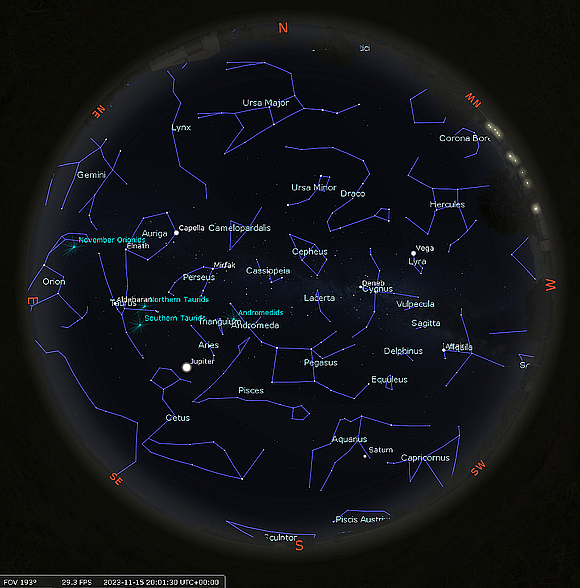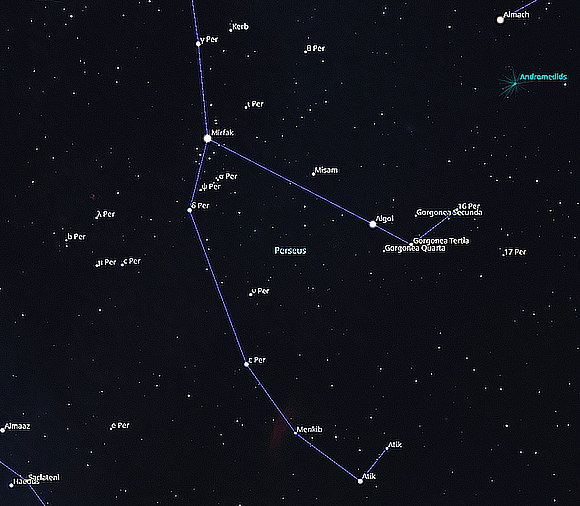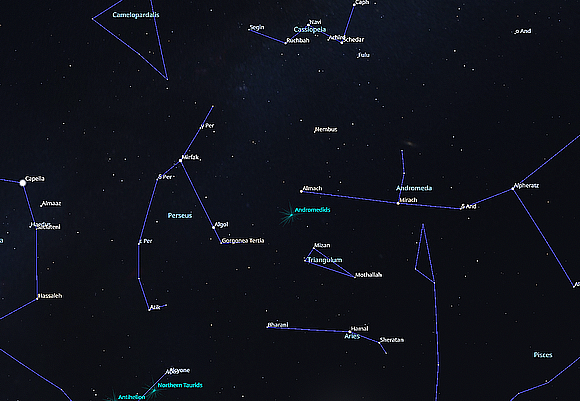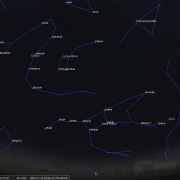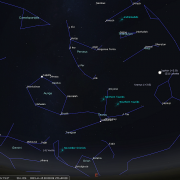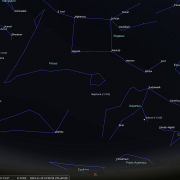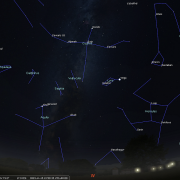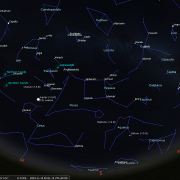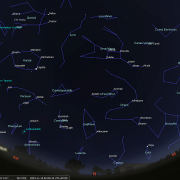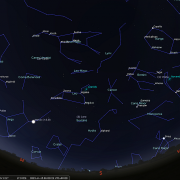cIn this month's Sky Notes:
Planetary Skylights: A Brief Guide to November's Night Sky
Jupiter reaches opposition early in the month dominating the night sky. Uranus also comes to opposition, in non-dominating fashion. Saturn is ideally placed in the evening sky. Neptune is visible as a telescopic object. The dawn sky belongs to brilliant Venus.
 Jupiter reaches opposition on November 3rd dominating the night sky, surpassed in brilliance only by Venus visible in the early dawn sky. Jupiter rises as the Sun sets at the start of the month, making it to 30 degrees above the SE horizon by 20:00hrs and culminating some 50 degrees above the S horizon. It does not drop back below 30 degrees altitude until after 03:45hrs affording UK observers an 8-hour viewing window. Residing in the southern part of Aries near the border with Cetus, Jupiter is in retrograde motion, moving east to west just above the loop of faint stars marking the head of Cetus.
Jupiter reaches opposition on November 3rd dominating the night sky, surpassed in brilliance only by Venus visible in the early dawn sky. Jupiter rises as the Sun sets at the start of the month, making it to 30 degrees above the SE horizon by 20:00hrs and culminating some 50 degrees above the S horizon. It does not drop back below 30 degrees altitude until after 03:45hrs affording UK observers an 8-hour viewing window. Residing in the southern part of Aries near the border with Cetus, Jupiter is in retrograde motion, moving east to west just above the loop of faint stars marking the head of Cetus.
At magnitude -2.85 Jupiter is unmissable providing observer friendly views through the eyepiece of large or small telescopes, even a humble pair of binoculars will reveal Jupiter’s oblate globe, a whopping 48 arc seconds in diameter resembling a bright sixpence.
Through 75mm (3”) scopes the dark equatorial belts will be obvious, the less dark polar regions also evident. Instruments more than 200mm (8") in aperture may also reveal the northern and southern finer temperate belts. When turned in our direction look for the great red spot feature, (appearing paler and smaller than 20 years ago). The GRS can be observed in 100mm (4”) scopes but will be more obvious with 150mm (6”) instruments at medium powers. Look for the GRS on the 2nd, 4th, 9th, 11th, 16th, 21st, 23rd and 28th around 19:00hrs GMT.
One Jovian system feature immediately evident are the attendant Galilean moons, the dance of these four large satellites over successive nights fascinating to follow. Visible as specks of light the configuration and number of the Galilean moons constantly evolve as they orbit around Jupiter. Look for Galilean moon shadow transits on the disk of Jupiter, of which there are numerous, the more favourable for late evening observers are as follows; Ganymede - Nov 10th around 19:00hrs and 17th from 23:30hrs GMT. Europa - Nov 21st around 21:00hrs GMT, and Io – Nov 6th @ 23:00hrs and Nov 22nd from 21:00hrs GMT.
The waxing first quarter Moon lies is in the vicinity of Jupiter on Nov 24th and 25th.
 Saturn is ideally placed for evening observation the ringed planet culminating due south around 20:00hrs GMT. At magnitude +0.3, Saturn is reasonably conspicuous amongst the faint stars of southern Aquarius - a region of the sky devoid of brighter stars. Saturn culminates a respectable 20 - 23 degrees above the south horizon from the UK, but still lies 11 degrees below the celestial equator. The good news is it will continue to gain in declination over the coming decade crossing into the northern half of the sky by 2026.
Saturn is ideally placed for evening observation the ringed planet culminating due south around 20:00hrs GMT. At magnitude +0.3, Saturn is reasonably conspicuous amongst the faint stars of southern Aquarius - a region of the sky devoid of brighter stars. Saturn culminates a respectable 20 - 23 degrees above the south horizon from the UK, but still lies 11 degrees below the celestial equator. The good news is it will continue to gain in declination over the coming decade crossing into the northern half of the sky by 2026.
Given the right conditions, Saturn can be a glorious spectacle through the eyepiec. Observers will note, however, that the orientation of the ring system is becoming less favourable closing up for the next ring plane crossing in 2025. Currently the rings are tilted by just 9 degrees making observation of the two major rings (ring A and B) rather more challenging for smaller instruments under 150mm (5"). The gap between them; the Cassini division, is discernible in larger instruments 200mm (8") plus. Saturn's largest moon, Titan, is visible as a speck of light nearby in nearly all instruments, several more moons are apparent in 150mm (6") scopes. On November 20th a Quarter Moon resides below left of Saturn.
 Neptune is well placed for telescopic observation having reached opposition last month. The official outermost planet resides approximately 15 degrees east of Saturn, below the faint loop of stars marking the western fish of Pisces in particular lambda Piscium (mag 4.5). The nearest 'bright' star is 5th magnitude 20 Piscium 30 arcminutes to the right of Neptune. Neptune itself is at magnitude +7.9 appearing as a minute 2.4 arc-second disc through the eyepiece.
Neptune is well placed for telescopic observation having reached opposition last month. The official outermost planet resides approximately 15 degrees east of Saturn, below the faint loop of stars marking the western fish of Pisces in particular lambda Piscium (mag 4.5). The nearest 'bright' star is 5th magnitude 20 Piscium 30 arcminutes to the right of Neptune. Neptune itself is at magnitude +7.9 appearing as a minute 2.4 arc-second disc through the eyepiece.
It is certainly not obvious even with a 150 (5”) instrument, even though Neptune is visible as a speck in humble 10x50 binoculars (if you know exactly where to look). Bear in mind Neptune is very remote, over 4.3 billion Km (2.67 billion miles) or 28.9 AU distant. Medium – high magnification coupled with steady seeing may just yield up the disk, larger apertures of 200mm (8”) plus will reveal the disk at medium powers. Avoid trying to track down when the Moon is in the vicinity.
 Uranus comes to opposition on Nov 13th, visible most of the night located around 6 degrees left of Jupiter and a similar distance to the right of the Pleiades star cluster. With a magnitude of mag +5.8 Uranus is technically visible to the naked eye, but very dark skies and good knowledge of its exact location are required to achieve this. An aperture of 75-80mm (3") will show the tiny 3.5-degree disk, soft green/grey in hue, whilst instruments above 150mm (6") will clearly reveal the disk. Uranus is currently in Aries, not far above the 'head' of Cetus, but is closing in on the Taurus/Aries border, culminating around midnight over 50 degrees above the south horizon and a viable observing object until 05:00hrs GMT. Delta Ari sits just over 2 degrees above Uranus, also nearby are 53 and 54 Ari with which it forms an isosceles triangle. A 'used' Full Moon lies above Uranus on Nov 26th.
Uranus comes to opposition on Nov 13th, visible most of the night located around 6 degrees left of Jupiter and a similar distance to the right of the Pleiades star cluster. With a magnitude of mag +5.8 Uranus is technically visible to the naked eye, but very dark skies and good knowledge of its exact location are required to achieve this. An aperture of 75-80mm (3") will show the tiny 3.5-degree disk, soft green/grey in hue, whilst instruments above 150mm (6") will clearly reveal the disk. Uranus is currently in Aries, not far above the 'head' of Cetus, but is closing in on the Taurus/Aries border, culminating around midnight over 50 degrees above the south horizon and a viable observing object until 05:00hrs GMT. Delta Ari sits just over 2 degrees above Uranus, also nearby are 53 and 54 Ari with which it forms an isosceles triangle. A 'used' Full Moon lies above Uranus on Nov 26th.
 Venus makes for a superb sight in the dawn sky, rising above the east horizon by 02:45hrs GMT as November commences. At magnitude -4.3 Venus certainly catches the attention of early risers climbing to more than 30 degrees in elevation by 06:00hrs. Venus can appear over dazzling through the eyepiece, so, if possible, wait until skies begin to lighten a little to better discern the phase, waxing quarter phase in nature.
Venus makes for a superb sight in the dawn sky, rising above the east horizon by 02:45hrs GMT as November commences. At magnitude -4.3 Venus certainly catches the attention of early risers climbing to more than 30 degrees in elevation by 06:00hrs. Venus can appear over dazzling through the eyepiece, so, if possible, wait until skies begin to lighten a little to better discern the phase, waxing quarter phase in nature.
On Nov 9th a waning crescent Moon lies less than one degree from Venus making for a fine conjunction and photographic opportunity. View around 06:15 - 06:30hrs GMT to capture the view in twilight sky. This conjunction will continue, eventually becoming an occultation with the Moon sliding in front of Venus but during broad daylight around 09:40hrs GMT. If you want to observe this and have a GOTO telescope - set up Venus in the eyepiece much earlier in the dawn - when skies are dark. You could do the same manually - but be prepared to keep either the Moon or Venus centred for over 2 ½ hrs. Venus will re-emerge from the 'dark' side of the Moon by 10:42hrs GMT. You must also be mindful of the Suns location in the sky.
9th Nov @ 06:30hrs GMT - close up of Venus and crescent Moon conjunction.
(Click for full-sized image)
9th Nov @ 09:37hrs GMT - close up of Venus and crescent Moon conjunction.
(Click for full-sized image)
November Meteors
The Leonid’s are considered the main meteor shower this month active from Nov 15-20th, usually peaking over the night of the 17/18th. The shower is famous for the periodic outburst in intervals of roughly 33 years of storm level activity, sometimes reaching many thousands of meteors per hour. Away from 'storm peak' years, Leonid activity is very modest amounting to 10-20 per hour at best, as will be the case for 2023. One favourable factor this year is the timing of the Leonid peak, 06:00hrs GMT on Nov 18th, that and the lack of moonlight, ensuring observers viewing from 02:00hrs until dawn should spot a dozen or so Leonids. The constellation of Leo (the radiant of the shower) is then arcing high over southern horizon and ideally placed from the UK. Pre-dawn hours nearly always yield the best rates. The shower is associated with comet 55/P Temple-Tuttle, which returns to the inner solar system every 33 years, leading to 'storm rates' of 100s, 1000s and even 100,000s meteors per hour. The next 'storm' level event is predicted to be November 2031 or 2032. Leonids are some of the swiftest meteors, penetrating the upper atmosphere at speeds of 45mps or 72 km/second, often leaving bright and persistent trains in the sky. If the night of 17/18th is clear, keep one watchful eye open at least!
Also in November, keep the other eye open for a few meteors on the night of 4/5th Nov when the South Taurid meteor shower reaches a peak. A second peak follows on the night of Nov 11/12 for the North Taurid meteor shower. The hourly rate is low for both showers; only around 5 meteors, but these can be bright with occasional fireballs! The Taurids are an old shower, associated with the periodic Comet Enke. Over time dust from this comet has been depleted and spread out over a broad swath of the inner solar system, giving rise to Taurid meteor showers not only on Earth, but also on Mars and Venus too!
Partial Lunar Eclipse –28th October
It was a lovely big Full Moon on Oct 28th – riding up from the east horizon atmospherically veiled by low cloud. Yes, it was a lovely Moon, right up until it became totally obscured by thicker cloud for the remainder of the night. It may have only been a 14% partial lunar eclipse, but it would have been nice to glimpse it. C'est la vie!
Finally, Richard Randle managed to image a fireball on the night of Oct 13th following the Westerdale event. The view is from Saltwick looking toward Black Nab. Orion is climbing over the horizon, with Taurus and the Pleiades above.
November Night Sky
November is rapidly becoming the month for all seasons, unseasonably mild, occasionally cold and wintery, dry, and calm, wet and windy - November can have interludes encompassing all of these conditions. Trees will shed the last of their colourful leafy autumn coats, so that winter will appear to be just around the corner. Skies fall dark before 18:00hrs, frost bitten only occasionally these days as the impact of climate change appears to insulate from early signs of wintery conditions.
Above our heads the constantly evolving celestial tapestry never lies still, winter constellations clamber over the east horizon by mid-month, and even on the cusp of winter, early evening skies in the west reflect seasons long gone. Here the stars of the summer triangle; Vega, Deneb, Altair, and associated constellations, remain conspicuous as darkness falls, well suited to observations then. Deneb shines atop the Northern Cross (Cygnus), which now really does resemble the outline of a crucifix as it descends towards the WNW horizon. High in the NW, brilliant steely-blue Vega illuminates the lozenge outline of Lyra, both it and Deneb circumpolar from our latitude remaining visible throughout winter, dipping close to the north horizon. Only Altair in Aquila the Eagle will depart, vacating our skies mid-month shortly after 22:00hrs seeking quarry in warmer regions of the world.
Facing north the familiar ‘saucepan’ asterism of the Plough in Ursa Major has now reached its lowest station on its endless journey about the celestial pole conveniently marked (almost) by Polaris - the Pole star, situated a couple of hand-spans above. Utilise the pointer stars; Dubhe and Merak in the 'bowl of the Plough for this purpose. Polaris sits at the tip of Ursa Minor’s tail. Between these two celestial bears wind the faint stars of Draco, the head of which, marked by an irregular quadrilateral, resides to the right of Vega in the WNW. Use the 'arc' of the Plough's handle to locate the brilliant star Arcturus setting in the NW in the late spring constellation of Boötes, although its journey below the horizon is short, rising again in the ENE by 03:00hrs GMT from mid -UK latitudes.
Departing with Boötes, Corona Borealis and the upper body of Hercules (technically lower body as Hercules is depicted as being upside down on stellar charts). Again, their absence is temporary, visible in the NE before dawn. Due South, arranged below the great square of Pegasus reside the constellations of Pisces and Aquarius, neither group blessed with conspicuous stars. Saturn currently resides below the loop of stars marking the western fish. The large constellation of Cetus the whale resides below Pisces, use the front two stars in the square to locate its brightest star Diphda.
The most famed object in Cetus is the variable star omicron ceti - otherwise known as Mira the wonderful, an extraordinary pulsating red super giant - perhaps 300 million miles in diameter. When at maximum, a period lasting some 10 days, Mira is easily visible to the naked eye and can rival Menkar. Mira’s slow decline to minimum takes seven months by which time binoculars struggle to pick out the +10.2 star! The whole period takes 332 days, with the next maximum not expected until May 2024. Mira lies roughly midway between Menkar and Diphda.
Capricornus occupies the SSW horizon, departing mid-evening by the month's end. Do try to spot conspicuous Fomalhaut in Pisces Austrinus, visible just above the SW horizon during early/mid evening until around 20:00hrs. It is the most southerly of first magnitude stars to rise over UK mainland shores. Scheat and Markab in the 'square' point down to it.
High to the South, stretching eastwards away from Pegasus, the stars of Andromeda sweep up toward the heroic figure of Perseus climbing high into the ENE. The constellation of Perseus itself lies partly within the rich Milky Way and well worth exploring with augmented eyes, whether binoculars or a telescope. Alpha Persei or Mirphak (sometimes written Mirfak) is the brightest star in the constellation, however, Beta Persei, or Algol is of far more interest.
The name Algol (Demon's head) is derived from an Arabic name, Ras al Ghul, a 'Ghul' being a nightmare which haunted and ultimately destroyed men. Star maps in antiquity depict Perseus holding the severed head of Medusa, which is marked by Algol, but it is doubtful if the Arabs knew of the Perseus–Medusa legend. In early antiquity it was noted with much consternation that this star appeared to ‘wink’ every third night, fading in brightness before returning to its former glory. The Greeks probably noted the mysterious phenomena first, but many ancient and medieval astrologers considered Algol the most dangerous and unfortunate of stars.
Science has long since uncovered the truth, we now know it to be an eclipsing binary star - two stars in orbit about one another, one bright and the other fainter. Every 2 days and 21 hours the fainter companion star passes in front of the more luminous primary and the overall light output from Algol drops. The eclipse lasts for almost 10 hours before the ‘demon star’ returns to normal.
Also, in this part of the sky, seek out the superb 'Double Cluster', an exquisite duo of galactic star clusters that lie midway between Perseus and Cassiopeia and mark the sword hand of Perseus. Visible as misty knots in binoculars, at low magnification through small/medium instruments H and Chi Persei (NGC 869 & NGC 884) is one of the finest sights in the heavens. Perseus is the hero in one of the best-known mythologies, saving the sacrificial Princess Andromeda from the Cracken sea monster sent to devour her and ravage the coastal towns and cities of ancient Ethiopia, the Kingdom of boastful Queen Cassiopeia and her husband King Cepheus. The winged horse of Pegasus, being a more modern insertion into this ancient legend. This mythological tableau is now ideally arranged across the autumn sky to the south and east.
The faint pattern of Cepheus is located overhead during November evenings and resembles the outline of a crooked house. (see October night sky feature) Cassiopeia, the 'W', is a most distinctive constellation for obvious reasons, through which flows the Milky Way and well worth spending time exploring with a pair of binoculars or telescope. Climbing away from the NE horizon, following Perseus, the imposing pentagonal shape of Auriga the Charioteer illuminated by brilliant Capella is ascending toward the zenith, the position overhead.
Seasonal winter constellations begin to dominate the eastern aspect by mid-evening lead by Taurus which adjoins Auriga at the star Al Nath. Taurus contains the two well-known star clusters, the Pleiades and the Hyades, the prominent ruddy star - Aldebaran 'the eye of the bull’, conspicuous in the latter. At 65 light years Aldebaran is however not a genuine member of the Hyades lying at half the distance of the true members in the ‘V’ or arrowhead arrangement of stars. The bull’s tail swishes upper right of the Hyades and is marked by the Pleiades, or ‘Seven Sisters’, regarded as perhaps the loveliest open star cluster in the entire heavens. To the casual glance the Pleiades appear as beads of dew on a frosty web. Keen sighted observers can make out more than seven stars with the naked eye, although most people see five or six. Binoculars, or very low telescopic magnifications reveal dozens of stars, and the entire cluster contains over 380 members approximately 410 light years away. The cluster is moving through a small gas and dust cloud giving rise to the nebulosity we see lit up in images.
From Greek mythology the Pleiades were the seven daughters of Atlas and the Oceanid Pleione, after whom they are named. Orion is said to have pursued the sisters for seven years after trying to ravish them and their mother. Zeus immortalized the chase by placing the Pleiades in the heavens. This is of course just a tale, but ancient Aztec and Mayan traditions tell of real and gruesome rituals associated with the Pleiades. Then, the midnight culmination of the star cluster was an event of ominous significance, especially so every 52 years when timelines of separately used calendars converged. Believing the world would end at such times, temple steps would run with the blood of virgins, sacrificed to postpone the approaching apocalypse. Travel to Mexico today and many of the sacred ‘step’ pyramids have their west face orientated to the setting position of the Pleiades.
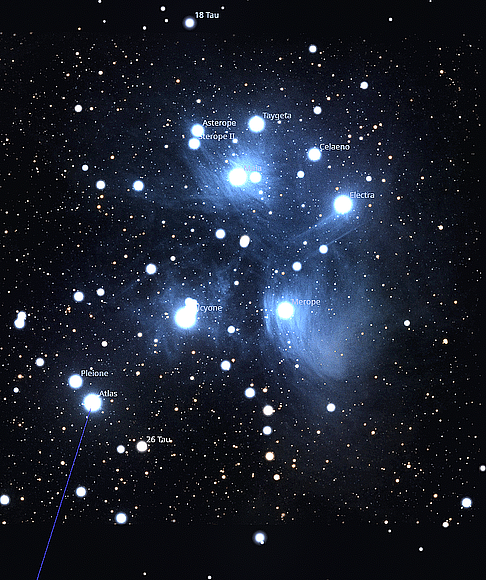
The Pleiades star cluster.
By mid-evening towards the end of the month the stars of Gemini, the Twins, the heads of whom are conveniently marked by the first magnitude stars Castor and Pollux clamber over the NE horizon. To their right considered the most majestic of all constellations, Orion, complete with starry belt and bright supergiant stars, clears the SE horizon by 22:00hrs. Over the coming winter months, Orion and his stellar retinue will be the focus of our celestial rambles, until then experience what the autumn has to offer.
November Sky Charts
Additional Image Credits:
- Planets and Comets where not otherwise mentioned: NASA
- Sky Charts: Stellarium Software and Starry Night Pro Plus 8
- Log in to post comments


